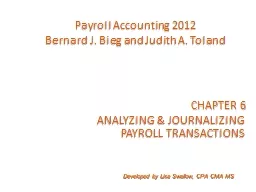

ANALYZING amp JOURNALIZING PAYROLL TRANSACTIONS Payroll Accounting 2012 Bernard J Bieg and Judith A Toland Developed by Lisa Swallow CPA CMA MS Learning Objectives Record payrolls in appropriate records ID: 275584
Download Presentation The PPT/PDF document "CHAPTER 6" is the property of its rightful owner. Permission is granted to download and print the materials on this web site for personal, non-commercial use only, and to display it on your personal computer provided you do not modify the materials and that you retain all copyright notices contained in the materials. By downloading content from our website, you accept the terms of this agreement.
Slide1
CHAPTER 6
ANALYZING & JOURNALIZING PAYROLL TRANSACTIONS
Payroll Accounting 2012 Bernard J. Bieg and Judith A. Toland
Developed by Lisa Swallow, CPA CMA MSSlide2
Learning Objectives
Record payrolls in appropriate recordsUnderstand various deductions taken from employees’ gross payJournalize entries to record payrollPost to general ledger
Explain recording of payroll tax depositsUnderstand need for end-of-period adjustmentsSlide3
Accounting for Payroll Transactions
Payroll requires entering data (in order) in the following places:Payroll RegisterEmployee Earnings Records
General JournalJournalize gross wages and withholdingsJournalize payroll taxes and workers’ compensationJournalize period-end accrualsPost to General LedgerLO-1Slide4
Recording Gross Payroll & Withholdings
Any deduction that the employer makes from employee’s paycheck goes into a liability account (because they owe it to someone) such as:Group life insurance premiumsHealth insurance premiums
Purchase government savings bondsUnion duesDeferred compensation (contributions to pension plan)Child support/other garnishmentsLO-2Slide5
Methods of Paying Wages & Salaries
CheckSometimes separate payroll account maintained to make bank reconciliation process easierElectronic payment methods
EFTS (electronic funds transfer system)Electronic records created showing bank, account # and net payPay cards allow employer to deposit payroll into prepaid cardCard utilized like debit or credit cardOver 25% of employees who do not have bank accounts use theseFinal pay
Many states set time limit between termination and final wage pay out (depends upon whether worker left voluntarily)
CA and MI require immediate payment if employee is fired
LO-3Slide6
Journal Entries to Record Payroll
Journal Entry #1 - Record gross wages, withholdings and net pay Journal Entry #2 - Record employer’s payroll tax expense
These two journal entries are always the same in format. You must make both of them every time you issue any paycheck (even if cutting a check for one day’s wages, for example).LO-3Slide7
Journal Entry #1
Debit Wage Expense for gross payrollCredit each withholding account - they are all liabilitiesCredit cash (or wages payable) for net payroll
Journal entry #1Wage Expense 1,845.00FICA Taxes Payable - OASDI 114.39
FICA Taxes Payable - HI 26.75
Employees FIT Payable 174.00
SIT Payable 50.00
Group Insurance Payments W/H 191.00
Cash 1,288.86
LO-3Slide8
Journal Entry #2
Debit Payroll Tax Expense for total of all payroll taxes that employer pays Credit each account - they are all liabilities
Calculate all employer taxes utilizing varying wage bases and percentagesJournal entry #2Payroll Tax Expense 188.92FUTA Taxes Payable 1.72SUTA Taxes Payable 46.06FICA Taxes Payable - OASDI 114.39FICA Taxes Payable - HI 26.75
LO-3Slide9
Recording Deposit of Payroll Taxes
Look in general ledger for amounts dueDeposit 941 taxes
Deposit state income taxDeposit SUTA
LO-5Slide10
Workers’ Compensation Insurance
Workers’ compensation is an expense for the employer, who is required to purchase insurance to protect employees against work related injuries/disabilities Laws differ by statePremiums often calculated based on employment classification – stated in terms of $100 per payroll
Pay premiums in advance based on projected wagesThen, at year-end, report actual wages and pay additional premium or may receive credit towards next yearLO-5Slide11
Journalize Period-End Accruals
Accrued wages should be recorded for wages earned by workers, but not yet paid Journal entryWage Expense 1,589.96
Wages Payable 1,589.96Accrued vacation pay should be recorded for amount of vacation pay owed employees - many employers now merging sick time and vacation time Journal entryVacation Benefits Expense 520.00 Vacation Benefits Payable 520.00
Note: Not necessary to accrue payroll tax expense at year-end
LO-6